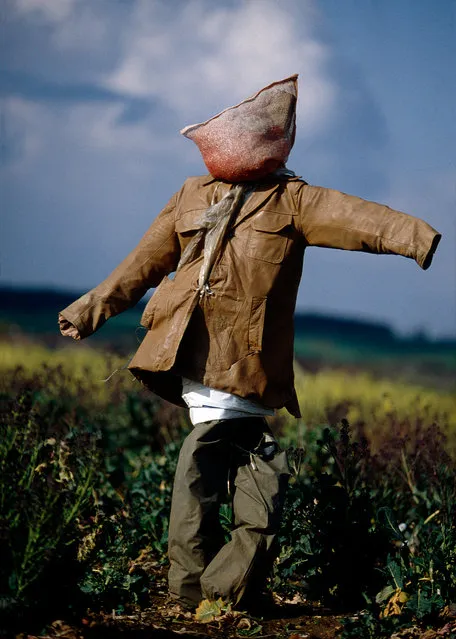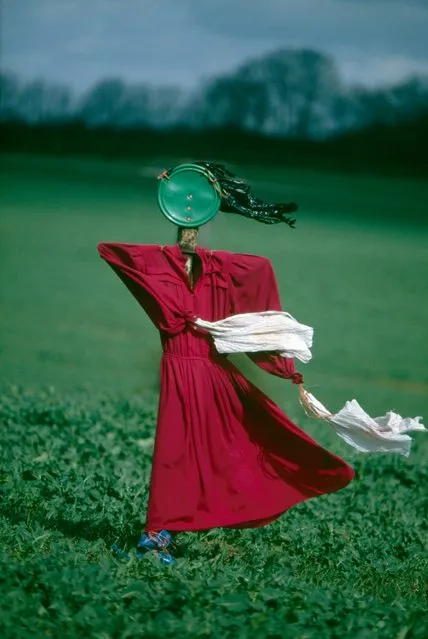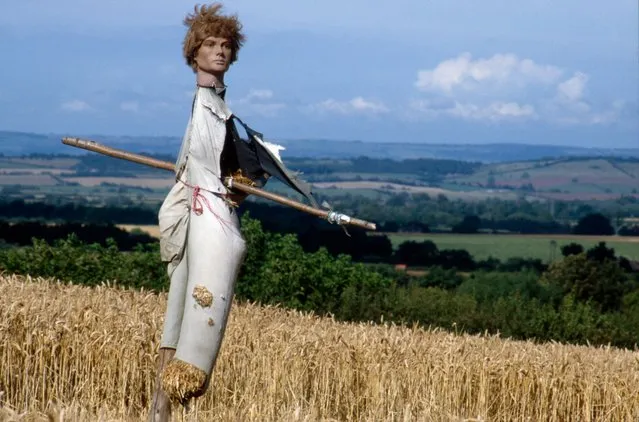
When Colin Garratt went to photograph the traditional sentinels of the British countryside, he found they ranged from the dapper to the downright sinister. “They are not from the anaesthetised world of the craft fair”, says Colin Garratt, “but are the direct descendants of the ancient spectres which have haunted the landscape for centuries”. The Scarecrow Exhibition is at Geddes Gallery, London, from 25 to 30 March. (Photo by Colin Garratt)

“Scarecrows have changed little over the centuries, although certainly they are better dressed today – in earlier times, vagrants and tramps were quick to strip them of any clothes worth wearing”. (Photo by Colin Garratt)

“The variety of scarecrows is infinite and all have their character. Some stand stiff, others are a ripple of movement. Some are rooted into the ground like trees, while others stride across the fields waving flags”. (Photo by Colin Garratt)

“A rare female scarecrow on a windy day in Northamptonshire – the rippling dress and billowing hair help her in her task”. (Photo by Colin Garratt)

“One significant aspect of the evolution of scarecrows is the use of plastic containers, along with other modern materials such as masks and boiler suits. This one was pictured in Braybrooke, Market Harborough”. (Photo by Colin Garratt)

“Some of those who create scarecrows believe that a face with an expression is an important factor in deterring predators; others are content with more abstract forms”. (Photo by Colin Garratt)

“It is always a great thrill to approach a new scarecrow. Will it have a face? Will it be sinister, happy, sad, aggressive, fiendish, stupid or just a friendly fool? It is well known that some of the most carefully made scarecrows are stolen, vanishing in the night”. (Photo by Colin Garratt)

“At the beginning of the year, scarecrows preside over early sowings of rape and wheat. In battering winter gales, driving rain and sleet, many scarecrows get blown into weird positions like drunks; or collapse”. (Photo by Colin Garratt)

“The ripening crops eloquently signify that the scarecrow’s work is done. Few remain to see their task fulfilled because if they become entangled in the harvesting machinery it causes serious damage”. (Photo by Colin Garratt)

“It is not unusual for passers-by to attack a scarecrow – stabbings and mutilations being the most common. Dead bodies have been hidden inside scarecrows, and stolen loot stashed in the pockets of their greatcoats”. (Photo by Colin Garratt)

“When among scarecrows, one gets an uneasy feeling of being watched. Some are so realistic and menacing that they appear to be alive. This was pictured north of Bedford”. (Photo by Colin Garratt)

“The English poet Walter de la Mare tells of a scarecrow that frightened both crows and men: “The way it bore itself up was more than you would expect from sticks and rags”. The vile apparition turned out to be the ghost of a man who took possession of the scarecrow to gain his revenge on a rival”. (Photo by Colin Garratt)

“One night I was filming scarecrows in a particularly lonely place. Absorbed in my task, I inadvertently backed up to a particularly hideous looking example and half turned to find it leering over my shoulder. My blood ran cold”. (Photo by Colin Garratt)
29 Mar 2016 11:46:00,
post received
0 comments
